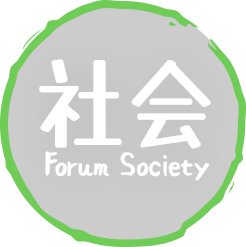Nogaku
Theatre
Noh (能), or
Nogaku (能楽),
which is a derivative of the words used for
‘Skill’ or
‘Talent’, is a form of theatrical art that was derived from
dance and festival drama prevalent at shrines or temples in the
late 12th and early 13th century. The art of Noh had become a
distinctive form of theatrics by the 14th century and continually
refined throughout the
Edo
period. During that time, Noh became an official ceremonial
art that was issued regulations and governance to standardize it to
emphasize tradition instead of innovation. Currently there
are five main troupes that continue to uphold these regulations and
traditions even today as they perform.
The Four Forms of Classical Japanese Theatre
Noh being one of four distinctive forms of classical theatre
alongside
Kyogen,
Kabuki, and
Bunraku, is also the oldest form of the
group and even thought to be the oldest existing form of theater in
the world. Although Noh is a form of drama that is set to entertain
instead of inspire laughter, its cousin art Kyogen are often paired
together. While they are very similar and considered to be the same
they are in many ways completely opposite in their
presentation.
Story Presentation
In Noh the story is told in a monotonous manner with very little
emotion, as if you were telling a story to friends or family. Many
of the stories told by Noh are folktales or common stories of Japan
that most people of the area would know already but the way it is
performed in Noh is what brings people to see it.
On the other hand, Kyogen is told with much more laughter and
dancing as a comedic or uplifting story. Noh makes heavy use of
masks to portray their characters with few other props to speak
other than the classic folding paper fan which can be used to
symbolize many things depending on how it is handled, from a paper
lantern to a sword. Kyogen on the other hand uses no such masks
unless the actor is to portray a physical transformation of sorts,
however, the props are generally the same being that Kyogen is
generally much shorter then Noh.
The Story of the Masks
The masks and props of this traditional form of theater differ very
little from performance to performance. The actors are to convey
their role through their story telling more than the costume or
prop; the skill of the actor themselves being weighed much more
heavily than how they use any other object. The actor themselves
however are usually to show no emotion in their voice.
Emotion in the show is often portrayed on the mask itself as either
a change of mask or a simple change of lighting applied to the
actor in the mask, weighing even more heavily on the ability to
tell a story by the actor as they perform. There are only a handful
of masks that are in use in any single troupe of performers. They
are general and usually used to portray something simple along the
lines of
‘Old man’,
‘Demon’, or
‘Young
Girl’.
In most performances only the main character is to wear a mask to
bring attention to them, however it is not unheard of for some
important supporting roles to also wear masks. Along with the masks
Noh is also known for its very extravagant and elaborate clothing.
These articles of clothing are deliberately aggrandizing to set in
contrast the stage in its bare décor and lack of props.
The Noh Program
The typical Noh program consists of five separate plays divided by
three or four
Kyogen, traditionally.
However, today's Noh are more likely to consist of only two or
three plays divided by one or two Kyogen. As previously mentioned,
most Noh plays are commonly known stories to the Japanese people,
these number in about
240 stories and are
separated into
5 different categories.
The categories for these stories are numbered from one to five and
are referred to by their number when talked about. The first
category is
Kami mono (神物),
which features a story about a human in the first half of the show
which later transitions to a deity in the second. Kami mono is
often a story of a specific shrine or to praise a particular
spirit. The category referred to as
‘two’ is
Shura mono (修羅物).
In this distinction, the actor is often portrayed as a spirit only
to be shown as a warrior in full battle gear in the second half to
reenact the scene of said characters death. Third, we have
Katsura mono (鬘物) or
‘Wig
plays’ are the stories of women and are usually the shows with
the most enthusiastic dances and songs in all of Noh. Next in the
categorization at number four is for the miscellaneous shows. Among
them being
kyouran mono (狂乱物),
onryou mono (怨霊物), and
genzai mono (現在物).
These plays are used to show the current time and generally cannot
quite fit into any other category. Last on the list, being number
five is
Kiri nou (切り能) or
oni mono (鬼物). These plays are
saved for last in the line-up as they are the most dramatic,
showing the actor in the roles of a demon, monster, or other
creature from Japanese folklore and is filled with bright colors
and fast paced movement fitting of a finale.
The Stage
Just as well, the stage of the Noh performances are incredibly
important. Despite being nearly bare and seemingly quite ordinary
much like the rest of the performance, they are in fact very
deliberate. A Noh stage is designed after many of the
Shinto shrine's Kagura stages and crafted
almost entirely from
Hinoki
(Japanese Cypress) wood. Traditionally, these stages are
created outdoors with small roofs that cover just the stage.
Each pillar is named in accordance with the direction they are to
represent in the current story unfolding on stage. Near the front,
right pillar, known as the
Waki-bashira, is where the supportive actor
usually stands during the show. This role is known as
Waki.
On the other side in the rear, left corner is where the
Shite is placed throughout the
performance, this pillar is known as the
Shite-bashira. In the rear, right corner is
the
fue-bashira and is closest
to the
flutist. Finally, in the front left is the
metsuke-bashira. This translates
roughly to
‘Sighting pillar’ and is so-named because the
Shite use this pillar for navigation when their vision is hindered
with a mask or prop. The floors of this stage are highly polished
like most revered Japanese buildings but the sheen on these floors
is to allow the actors a gliding movement with their performances
instead of esteemed appearances.
The only ornamentation of the stage is the backdrop which is a
large painting of a large tree, said to be
Pine. The
significance of this tree is thought to be either a representation
of a famous pine in
Kasuga
Shrine located in
Nara or
thought to be a symbol of the Noh’s artistic heritage which were
often performed with a natural backdrop near an already existent
forest or tree.
The Prominency of Noh Theatre
The traditional and entertaining form of theatrics known as Noh is
still very prominent with over
1,500 people within
the five troupes that still perform regularly, attracting young and
old with their captivating stories. Whether on vacation or
temporary residence, chances are anybody visiting will hear about
or be lucky enough to even see one of these performances locally in
Japan.
A ticket to a Noh performance in 2014 will cost somewhere between
5,000 to
8,000yen (
approx $40
- $70USD) and can be bought over the counter at the performance
theater, though usually only for the new indoor stages. The
antiquated outdoor stages are
rarely used and hard to
obtain tickets for as they are only done on special occasion. They
garner significant attention for how small the stages usually
are.
Thank you for reading our editorial on Noh Theare! If you would
like to read more cultural editorials you can continue
here.
This editorial was generously written by
Alice!



























